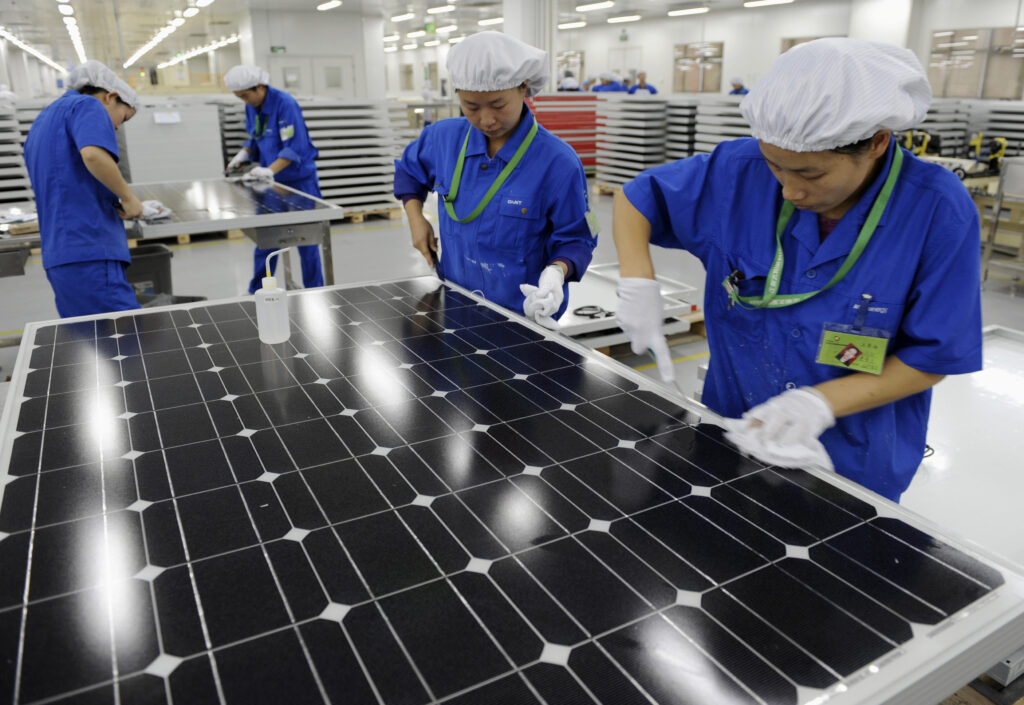

With wavering Western commitment casting a gloom over global climate governance, China’s closely watched government work report has sent a reassuring message that the world’s second-largest economy will continue pursuing its low-carbon agenda.
The work report, which Chinese Premier Li Qiang delivered to the national legislature last Wednesday (March 5), set the 2025 goal of achieving a drop of around three per cent in energy consumption per unit of GDP. It also outlines more measures to realise China’s dual carbon goals of peaking carbon emissions before 2030 and attaining carbon neutrality before 2060.
Among the new measures are accelerating the construction of new energy bases in deserts, the Gobi and other arid areas, and developing offshore wind farms. In recent years, China’s arid northwest and windy coastal regions have risen as clean energy hubs, with burgeoning solar and wind farms.
The work report also noted that the country plans to establish a group of zero-carbon industrial parks and factories, and to expand the China Carbon Emission Trade Exchange to cover more sectors. Low-carbon upgrade trials will also be launched in coal-fired power plants.
“We will actively engage in and steer global environmental and climate governance,” the premier said when delivering the work report.
The policy package is the latest in a series of climate commitments China has made amid rising concerns over the United States’ withdrawal for the second time from the Paris Climate Accord.

“China’s determination and actions to actively address climate change remain consistent,” Guo Jiakun, a foreign ministry spokesperson, said in late January.
“I believe China won’t waver in its commitment to addressing climate change, as this aligns with the country’s pursuit of sustainable development,” said Jin Zhijun, a national lawmaker and an academician of the Chinese Academy of Sciences.
Over four years after announcing its dual carbon goals, China now boasts the largest and fastest-growing renewable energy capacity globally. In 2023, more than half of the world’s newly added renewable energy capacity was in China.
Solar power and wind energy have seen the fastest expansions, with respective increases of 278 million kilowatts and 79.82 million kilowatts in 2024, pushing China’s renewable energy capacity to a record 56 percent of the total national capacity, according to the National Energy Administration.
This clean energy transition, along with efforts to phase out outdated industrial capacities, helped China cut carbon dioxide emissions per unit of GDP by over 35 percent between 2012 and 2023.
Even coal-rich areas have ended the dominance of fossil fuel in their energy structures. Last year, the new energy capacity exceeded the coal-fired capacity for the first time in Shanxi, the country’s leading coal producer, and in Inner Mongolia and Ningxia, both major thermal power producers in China’s north and northwest.

The newly operational Narisong photovoltaic base in Jungar Banner, a coal-producing area in Inner Mongolia, is a model of this nationwide low-carbon transition.
Nestled in the Kubuqi Desert, the solar power plant is one of the desert new energy bases mentioned in the government work report. The solar plant will channel most of its electricity to power a nearby plant, which will turn water into oxygen and hydrogen—another form of clean energy—after the factory begins operations later this year.
“We’re trying to make hydrogen production 100 per cent green with zero air pollution,” said Ji Mengbo, a chief engineer at the solar plant.
Officials have hailed the solar-hydrogen project as a flag-bearer for local efforts to reduce carbon footprints while boosting economic growth. Jungar Banner has built an industrial cluster supplying components for local solar, wind and hydrogen power generation.
“We aim for a breakthrough in new energy equipment manufacturing in 2025, with photovoltaic modules, hydrogen storage equipment, wind turbine systems and related sectors exceeding ¥60 billion (about US$8.3 billion) in output,” said Liu Zhou, head of the banner’s energy administration.
China is now the world’s largest producer of solar panels and wind energy equipment. Experts say the country’s manufacturing prowess and the Chinese government’s dedication have helped deliver a thriving new energy industry and brought down the costs of widespread applications.
According to Heymi Bahar, a senior analyst at the International Energy Agency, China accounts for approximately 80 per cent of global solar photovoltaic module manufacturing and has driven an over 80 cent reduction in solar panel prices over the past decade, helping countries worldwide expand their photovoltaic deployments.

Jiang Ying, chair of Deloitte China and a member of the Chinese People’s Political Consultative Conference National Committee, said that China’s technological breakthroughs in new energy, energy storage and green manufacturing will continue to lower the costs for the world’s green transformation.
“The country’s expanding green consumption market, which includes new energy vehicles, renewable energy and green architecture, will also create plenty of opportunities for international companies,” Jiang said.







Comments